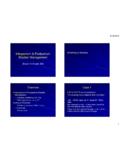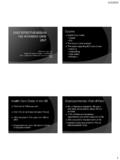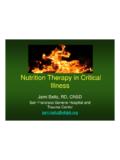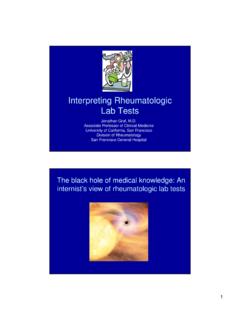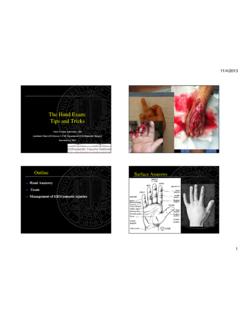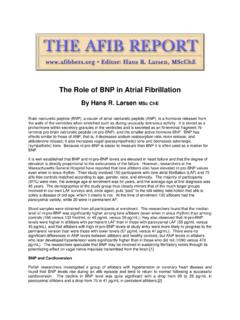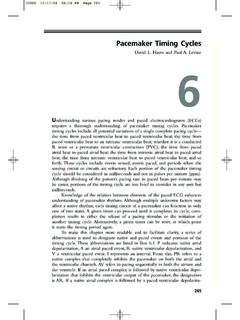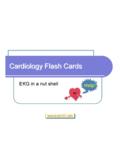Transcription of New Treatment Guidelines in Atrial Fibrillation and ...
1 7/23/20151 New Treatment Guidelines in Atrial Fibrillation and Updates on NOACsDean Schillinger MDProfessor of MedicineUniversity of California, San FranciscoSan Francisco General Hospital & Trauma CenterDisclosuresI have nothing to disclose7/23/20152 Session Objectives To review selected recommendations from the 2014 AHA/ACC Guidelines on AF Discuss how your management of patients with Atrial Fibrillation might be impacted Review evidence on Novel Oral Anticoagulants (NOACs)2014 AHA/ACC/HRS Guideline for the Management of Patients with Atrial FibrillationA Report of the American College of Cardiology/American Heart Association Task Force on Practice Guidelines and the Heart Rhythm SocietyDeveloped in Collaboration With the Society of Thoracic SurgeonsPublished in: Circulation.
2 2014; 1297/23/20153 Guideline clinical controlStrength of Recommendations:Class and Level of Evidence Size of Treatment Effect Class I: you SHOULD do it (benefit >>> risk) Class IIa: it is REASONABLE to do it (benefit >> risk) Class IIb: may CONSIDER doing it (benefit risk) Class III: no benefit or harm exists (Don t do it!) Estimates of Certainty of Treatment Effect Level A: strong evidence, multiple populations Level B: moderate evidence, limited populations Level C: weak evidence, very limited populations7/23/20154 Case An 81 yo woman with a history of anti-Western medicine beliefs, HTN and fall risk c/o periodic palpitations. Ambulatory ECG reveals NSR. A 72 hour-Holter demonstrates rare runs of SVT at 140, but no other arrhythmia.
3 She is started on a Beta Blocker, which she only sporadically takes. 12 months later, she presents to ED 3 hours after experiencing aphasia and hemiparesis. She receives TPA and is hospitalized; her neuro sx resolve. Inpatient work-up is -. She receives an outpatient Zio-patch which demonstrates that she is in AF for 10% of the time. SHOULD SHE BE ANTI-COAGULATED?Initial Evaluation of AF7/23/20155 Initial Clinical Evaluation Establish the diagnosis of AF using ECG (Class IC) Characterize the type of AF Define (and treat) associated medical conditions CHF, hypertension Assess symptom burden Assess thromboembolic riskAF: ClassificationType of AFDefinitionParoxysmalAF episodes last < 7 daysPersistentContinuous AF > 7 daysLongstanding persistentContinuous AF > 12 monthsPermanentNo further efforts to restore sinus rhythm are possibleNon-valvularNo rheumatic mitral stenosis, prosthetic heart valve, or mitral valve repair7/23/20156 Initial Evaluation ECG, telemetry, or event recorders Transthoracic echocardiogram to detect underlying cardiac disease, evaluate cardiac function, and measure left Atrial size Other tests as appropriate Sleep study, thyroid evaluation.
4 Pulmonary evaluationPrevention of Thromboembolism7/23/20157 Preventing Thromboembolism Individualize decision-making on antithrombotic therapy based on stroke risk, bleeding risk, and patient s values and preferences (Class IC) Periodically re-evaluate need and choice of antithrombotic therapy (Class IC) It doesn t matter if AF is paroxysmal, persistent, or permanent stroke prevention is the same (Class IB)Case Revisited An 81 yo woman with a history of anti-Western medicine beliefs and HTN and fall risk c/o periodic palpitations. Ambulatory ECG reveals NSR. A 72 hour-Holter demonstrates rare runs of SVT at 140, but no other arrhythmia. She is started on a Beta Blocker, which she only sporadically takes.
5 12 months later, she presents to the ED 3 hours after experiencing aphasia and hemiparesis. She receives TPA and is hospitalized; her neuro sx resolve. Inpatient work-up is --. She receives an outpatient Zio-patch which demonstrates that she is in AF for 10% of the time. SHOULD SHE BE ANTI-COAGULATED?7/23/20158 Estimate Stroke Risk Calculate CHA2DS2 VASc score (Class IB) Congestive heart failure (1 point) Hypertension (1 point) Age 75 years (2 points) Diabetes mellitus (1 point) Stroke/TIA (2 points) Vascular disease (1 point) Age 65-74 (1 point) Sex: Female (1 point) Score can be calculated to an annual stroke risk: Her score is 6 = annual risk of strokeAntithrombotic TherapyCHA2DS2-VASc ScoreRecommendation0No antithrombotic therapy (Class IIaA)1No antithrombotic therapy anticoagulant (Class IIbC)2 or higherOral anticoagulant(Class IA)7/23/20159 Calculate Bleeding Risk.
6 HAS-BLED score Derived from a cohort of ~4000 pts with AF Assesses 1-year risk for major bleeding (intracranial, hospitalization, hemoglobin decrease > 2 g/L, and/or transfusion) HAS-BLED*:*Note that this score does not include fall hx or risk Hypertension Abnormal Liver/Renal Function Stroke History Bleeding Predisposition Labile INRs Elderly (Age > 65) Drugs/Alcohol Usage Score can be calculated to an annual bleeding risk: Her score is 3 = annual risk of major hemorrhageChoice of Anticoagulants In patients with nonvalvular AF who need anticoagulation: Warfarin (Class IA) OR a novel oral anticoagulant (NOAC, Class IB) In patients with a mechanical heart valve, use warfarin (Class IB)7/23/201510 Novel Oral Anticoagulants Direct thrombin inhibitor: dabigatran Factor Xa inhibitors.
7 Rivaroxaban, apixaban(edoxaban) Consider if unable to maintain therapeutic INRs on warfarin (Class IC) Check renal function before initiating and monitor periodically afterwards (Class IB) Reduced dosing mightbe considered for patients with moderate to severe renal disease (Class IIbC) Not recommended for patients with end stage kidney disease (Class IIIC-no benefit/harm) Don t use in patients with mechanical heart valves (Class IIIB-harm)AF and Percutaneous Coronary Intervention Bare metal stents may be considered in patients with AF undergoing PCI to minimize need for concomitant anticoagulants + dual antiplatelet therapy (Class IIbC) In patients with AF and CHA2DS2 VASc 2 undergoing PCI, it may be reasonable to use clopidogrel concurrently with oral anticoagulants but without aspirin (Class IIbB)7/23/201511 Rate Control for AFRate Control Control the ventricular rate (Class I) Target heart rates < 80 bpm for symptomatic patients (Class IIaB) < 110 if asymptomatic and no heart failure (Class IIbB)7/23/201512 How to Control Rate Medications Beta-blocker (Class IB) Non-dihydropyridine calcium channel blocker (Class IB) Amiodarone (if failed other measures, Class IIbC) AV nodal ablation + permanent ventricular pacing if pharmacologic therapy is inadequate and rhythm control unachievable (Class IIaB)
8 Rate Control for Atrial FibrillationNo other CV diseaseLV dysfunction or HFHypertension or HFpEFBeta blockerDiltiazemVerapamilBeta blockerDiltiazemVerapamilBeta blockerDigoxinAmiodarone7/23/201513 Don t Dos Don tuse AV nodal ablation/pacing without an adequate trial of medications (Class IIIC-harm) Don tuse non-dihydropyridine CCBs in patients with decompensated HF (Class IIIC-harm) Don tuse digoxin, non-dihydropyridine CCBs, or IV amiodarone in patients with pre-excitation and AF (increases risk of VFib) (Class IIIB-harm) Don tuse dronedarone as rate control in patients with permanent AF (Class IIIB-harm)Rhythm Control for AF7/23/201514 Rhythm Control Treat reversible causes prior to initiating antiarrhythmic drugs (Class IC) Antiarrhythmic drugs vs.
9 Catheter ablationAntiarrhythmic Drugs Recommended for treating tachycardia-induced cardiomyopathy (Class IIaC) Consider if there are infrequent, well-tolerated episodes of AF and Treatment reduces symptoms/frequency (Class IIbC) Discontinue if AF becomes permanent (Class IIIB-harm) Risks of anti-arrhythmic drugs should be considered prior to initiating therapy (Class IC)7/23/201515 Antiarrhythmic Drugs Amiodarone Should be used only if risks/side effects are considered and other agents are not suitable (Class IC) Dofetilide Dronedarone Don t use in heart failure (Class IIIB-harm) Flecainide Propafenone Sotalol Don t use in heart failure (Class IIIB-harm)Catheter Ablation May be useful for symptomatic patients who do not tolerate or have failed antiarrhythmic medications (Class IA) Might be a reasonable initial strategy in some patients Need to assess procedural risks and outcomes relevant to your individual patient (Class IC) Does not obviate the need for anticoagulation Should not be performed in patients who cannot be treated with anticoagulants peri-procedurally (Class IIIC-harm)7/23/201516 Catheter Ablation Symptomatic paroxysmalAF Consider for patients refractory or intolerant to at least 1 Class I or III antiarrhythmic medication (Class IA) Might be reasonable as an initialstrategy (Class IIaB)
10 Symptomatic persistentAF Reasonable for patients refractory or intolerant to at least 1 Class I or III antiarrhythmic medication (Class IIaA) Might be reasonable as an initialstrategy (Class IIbC) Symptomatic long-standing persistentAF (>12 mo): may consider if refractory or intolerant to meds (Class IIbB)Rhythm Control in SymptomaticAF without structural heart diseaseDofetilideDronedaroneFlecainidePr opafenoneSotalolCatheter ablationAmiodarone7/23/201517 Rhythm Control in symptomaticAF with structural heart diseaseCADH eart FailureDofetilideDronedaroneSotalolCathe ter ablationAmiodaroneDofetilideAmiodaroneAF : Summary of Key Points CHA2DS2 VASc should be used to determine stroke risk and need for anticoagulation Several choices for oral anticoagulation in AF After PCI, if bare stent not used.
